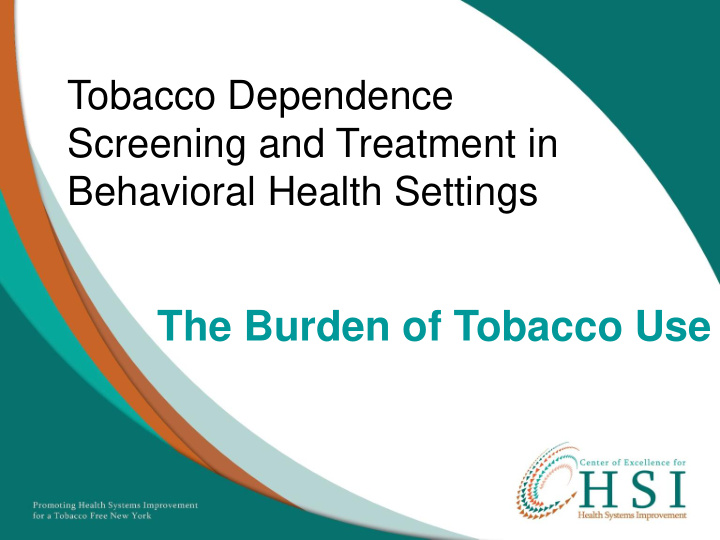



Tobacco Dependence Screening and Treatment in Behavioral Health Settings The Burden of Tobacco Use
Tobacco Use Causes Death • Tobacco use is the number one cause of preventable disease and death • Every year, approximately 25,500 New Yorkers die prematurely as a result of their tobacco use • More than 500,000 New Yorkers live with serious tobacco- caused illnesses and disabilities • Exposure to secondhand smoke causes about 3,000 premature deaths from diseases including heart disease, lung cancer, and stroke in NYS every year 2
Tobacco is Addictive • Most tobacco users become addicted to nicotine, a drug that is found naturally in tobacco • More people in the United States are addicted to nicotine than to any other drug • Research suggests that nicotine may be as addictive as heroin, cocaine, or alcohol • Quitting tobacco is hard and may require several attempts. • People who stop tobacco often start again because of withdrawal symptoms, stress, and weight gain. • Nicotine withdrawal symptoms may include feeling irritable, angry, or anxious, having trouble thinking, craving tobacco products and feeling hungrier than usual 3
Tobacco Use Rates & Mental Health • In NYS, smoking prevalence is 33.7% among adults with poor mental health compared to 14.3% among adults who do not have poor mental health. • 1 in 5 adults in the United States have some type of mental illness. 4
Tobacco Use Rates & Substance Use Disorders 5
Addressing Tobacco Use with Behavioral Health Patients • There are concerns about providing cessation services to behavioral health patients: o Don’t want to take tobacco away while they are trying to manage symptoms o Patient might leave treatment o Not sure how to implement or how staff will react • Despite challenges, it is important to implement treatment services • Individuals with a Behavioral Health condition, like all clients, want to quit, can quit and can benefit from proven stop- smoking treatments 6
Treating Tobacco Dependence Using Evidence-Based Strategies • Tobacco dependence is a chronic, relapsing disease that requires repeated intervention and multiple attempts to quit • Providers need to consistently identify and document tobacco use status and treat every tobacco user seen • Ongoing counseling, support, and appropriate pharmacotherapy are required to achieve long-term abstinence • Counseling and treatment need to be offered at every visit to every patient willing to quit to maximize their chances of successfully quitting 7
Recommend
More recommend